ECON 113 Report: Including Agriculture in NZ Emission Trading Scheme
VerifiedAdded on 2022/11/16
|7
|1314
|332
Report
AI Summary
This report examines the New Zealand Emission Trading Scheme (ETS) and the potential inclusion of agriculture within it, addressing a request from the Minister of Environment. The report begins with a description of the NZ ETS, followed by a presentation of the economic arguments for and against including agriculture. Arguments for inclusion highlight potential revenue generation, reduced greenhouse gas emissions, and economic benefits for farmers through cleaner practices. Arguments against include potential market inefficiencies, GDP reduction, and questions about the ETS's effectiveness, especially concerning the cost of cleaner technologies and the impact on production. The report concludes that, while acknowledging the effectiveness of ETS is questionable, it is important to address greenhouse emissions from agriculture in New Zealand due to the sector’s significance to the economy, recommending a combined approach of ETS and other mitigating policy initiatives. The analysis is supported by scholarly theory and available statistics, offering a comprehensive overview of the topic. The report concludes that, while acknowledging the ineffectiveness of ETS, other mitigating policy initiatives should also be considered.
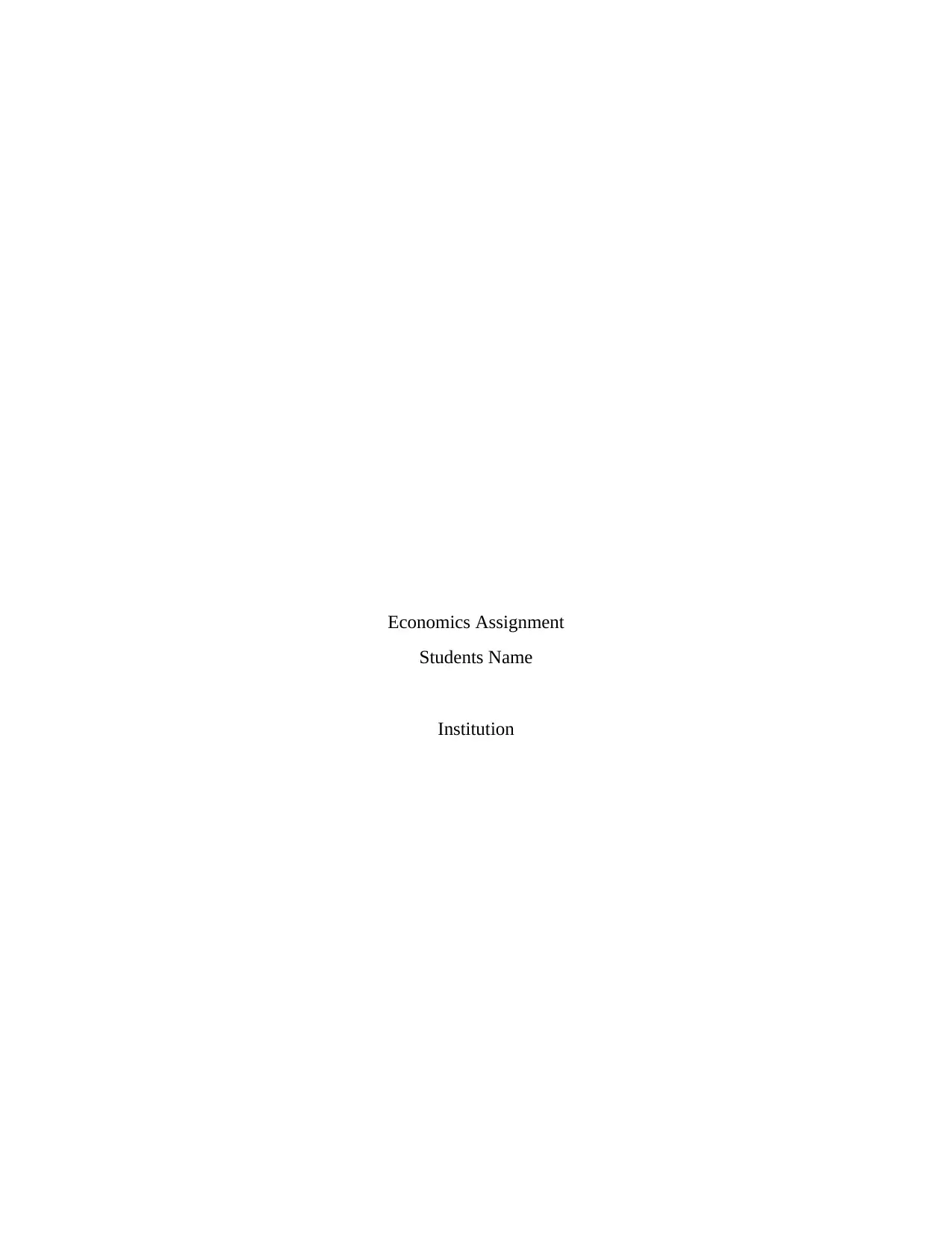
Economics Assignment
Students Name
Institution
Students Name
Institution
Paraphrase This Document
Need a fresh take? Get an instant paraphrase of this document with our AI Paraphraser
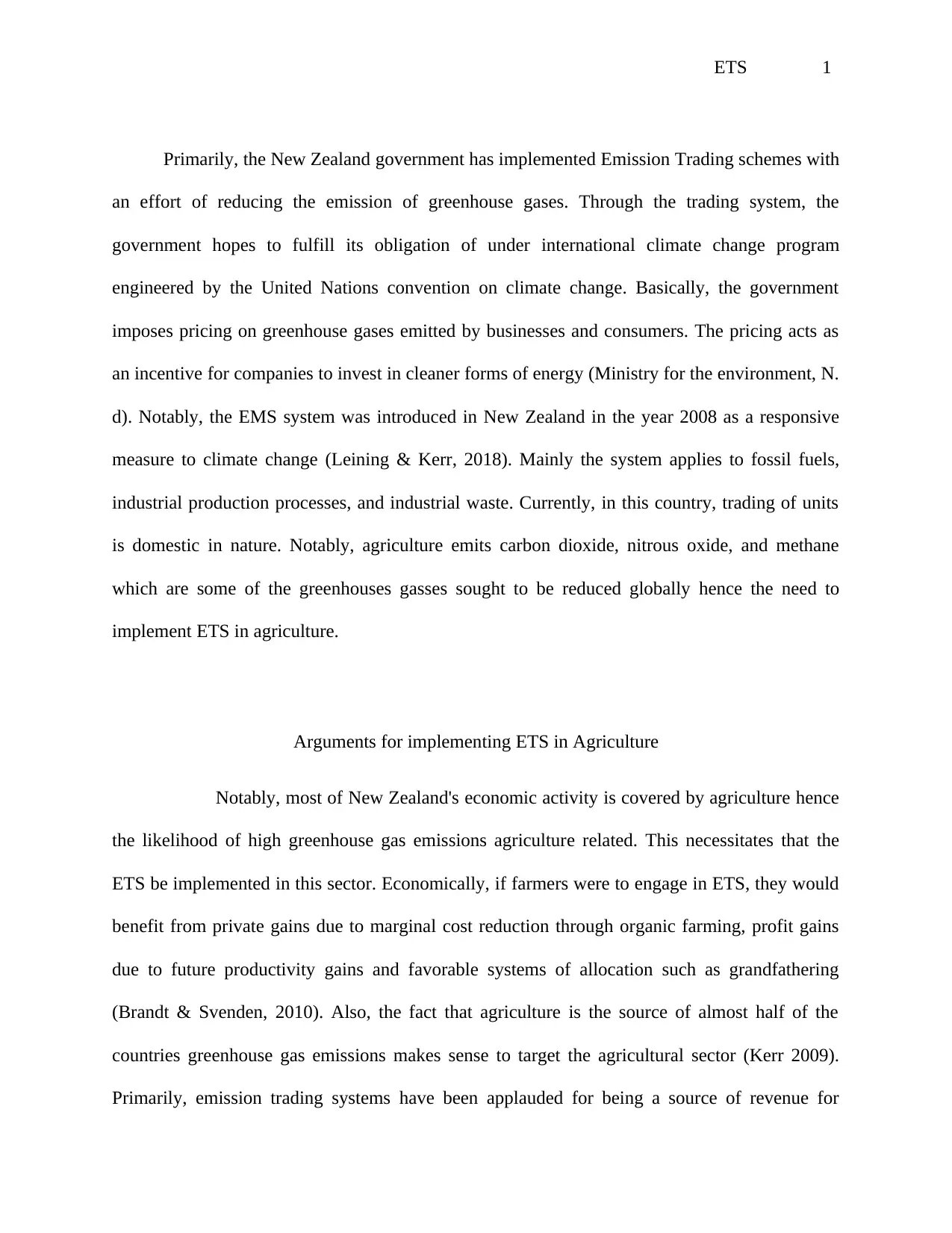
ETS 1
Primarily, the New Zealand government has implemented Emission Trading schemes with
an effort of reducing the emission of greenhouse gases. Through the trading system, the
government hopes to fulfill its obligation of under international climate change program
engineered by the United Nations convention on climate change. Basically, the government
imposes pricing on greenhouse gases emitted by businesses and consumers. The pricing acts as
an incentive for companies to invest in cleaner forms of energy (Ministry for the environment, N.
d). Notably, the EMS system was introduced in New Zealand in the year 2008 as a responsive
measure to climate change (Leining & Kerr, 2018). Mainly the system applies to fossil fuels,
industrial production processes, and industrial waste. Currently, in this country, trading of units
is domestic in nature. Notably, agriculture emits carbon dioxide, nitrous oxide, and methane
which are some of the greenhouses gasses sought to be reduced globally hence the need to
implement ETS in agriculture.
Arguments for implementing ETS in Agriculture
Notably, most of New Zealand's economic activity is covered by agriculture hence
the likelihood of high greenhouse gas emissions agriculture related. This necessitates that the
ETS be implemented in this sector. Economically, if farmers were to engage in ETS, they would
benefit from private gains due to marginal cost reduction through organic farming, profit gains
due to future productivity gains and favorable systems of allocation such as grandfathering
(Brandt & Svenden, 2010). Also, the fact that agriculture is the source of almost half of the
countries greenhouse gas emissions makes sense to target the agricultural sector (Kerr 2009).
Primarily, emission trading systems have been applauded for being a source of revenue for
Primarily, the New Zealand government has implemented Emission Trading schemes with
an effort of reducing the emission of greenhouse gases. Through the trading system, the
government hopes to fulfill its obligation of under international climate change program
engineered by the United Nations convention on climate change. Basically, the government
imposes pricing on greenhouse gases emitted by businesses and consumers. The pricing acts as
an incentive for companies to invest in cleaner forms of energy (Ministry for the environment, N.
d). Notably, the EMS system was introduced in New Zealand in the year 2008 as a responsive
measure to climate change (Leining & Kerr, 2018). Mainly the system applies to fossil fuels,
industrial production processes, and industrial waste. Currently, in this country, trading of units
is domestic in nature. Notably, agriculture emits carbon dioxide, nitrous oxide, and methane
which are some of the greenhouses gasses sought to be reduced globally hence the need to
implement ETS in agriculture.
Arguments for implementing ETS in Agriculture
Notably, most of New Zealand's economic activity is covered by agriculture hence
the likelihood of high greenhouse gas emissions agriculture related. This necessitates that the
ETS be implemented in this sector. Economically, if farmers were to engage in ETS, they would
benefit from private gains due to marginal cost reduction through organic farming, profit gains
due to future productivity gains and favorable systems of allocation such as grandfathering
(Brandt & Svenden, 2010). Also, the fact that agriculture is the source of almost half of the
countries greenhouse gas emissions makes sense to target the agricultural sector (Kerr 2009).
Primarily, emission trading systems have been applauded for being a source of revenue for
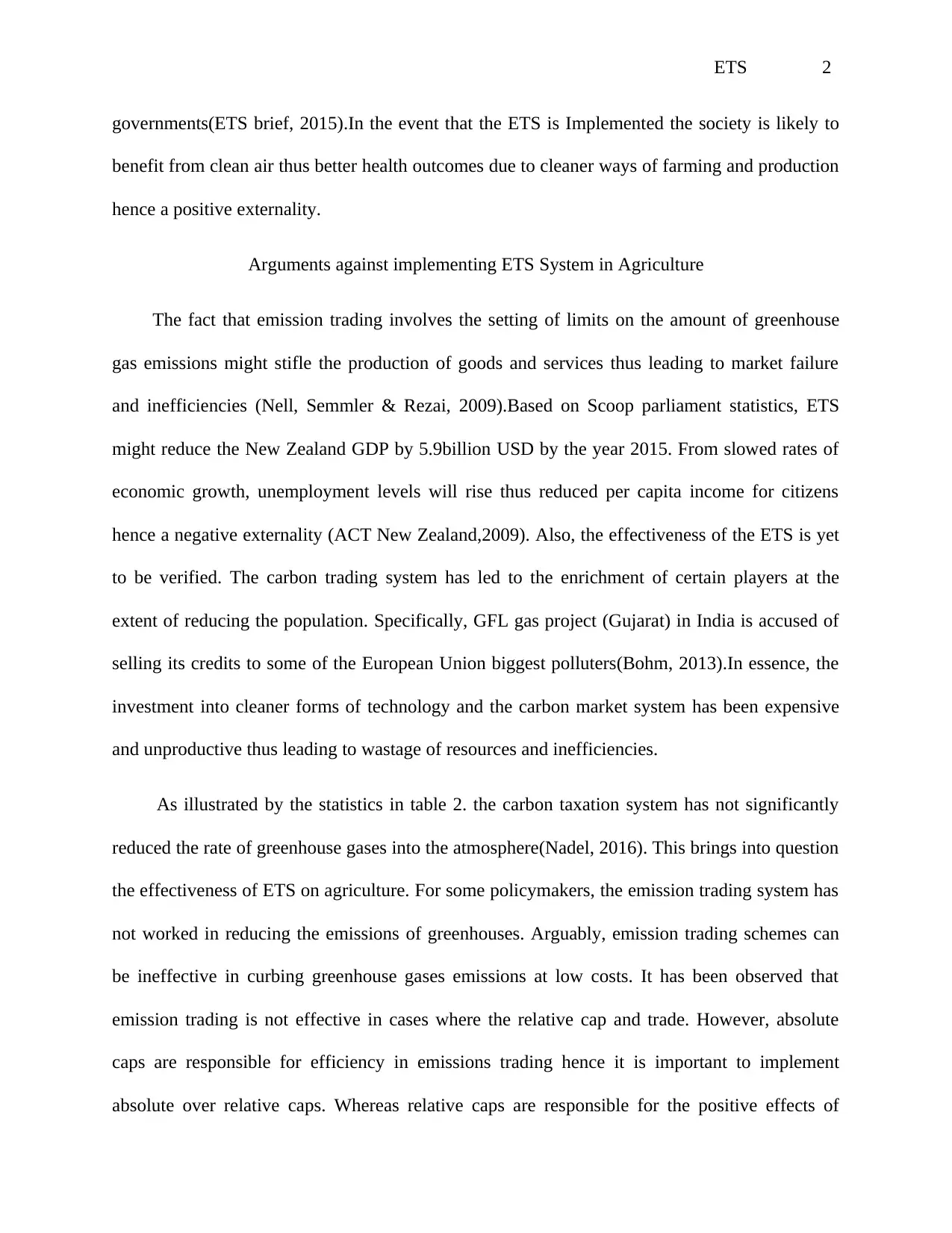
ETS 2
governments(ETS brief, 2015).In the event that the ETS is Implemented the society is likely to
benefit from clean air thus better health outcomes due to cleaner ways of farming and production
hence a positive externality.
Arguments against implementing ETS System in Agriculture
The fact that emission trading involves the setting of limits on the amount of greenhouse
gas emissions might stifle the production of goods and services thus leading to market failure
and inefficiencies (Nell, Semmler & Rezai, 2009).Based on Scoop parliament statistics, ETS
might reduce the New Zealand GDP by 5.9billion USD by the year 2015. From slowed rates of
economic growth, unemployment levels will rise thus reduced per capita income for citizens
hence a negative externality (ACT New Zealand,2009). Also, the effectiveness of the ETS is yet
to be verified. The carbon trading system has led to the enrichment of certain players at the
extent of reducing the population. Specifically, GFL gas project (Gujarat) in India is accused of
selling its credits to some of the European Union biggest polluters(Bohm, 2013).In essence, the
investment into cleaner forms of technology and the carbon market system has been expensive
and unproductive thus leading to wastage of resources and inefficiencies.
As illustrated by the statistics in table 2. the carbon taxation system has not significantly
reduced the rate of greenhouse gases into the atmosphere(Nadel, 2016). This brings into question
the effectiveness of ETS on agriculture. For some policymakers, the emission trading system has
not worked in reducing the emissions of greenhouses. Arguably, emission trading schemes can
be ineffective in curbing greenhouse gases emissions at low costs. It has been observed that
emission trading is not effective in cases where the relative cap and trade. However, absolute
caps are responsible for efficiency in emissions trading hence it is important to implement
absolute over relative caps. Whereas relative caps are responsible for the positive effects of
governments(ETS brief, 2015).In the event that the ETS is Implemented the society is likely to
benefit from clean air thus better health outcomes due to cleaner ways of farming and production
hence a positive externality.
Arguments against implementing ETS System in Agriculture
The fact that emission trading involves the setting of limits on the amount of greenhouse
gas emissions might stifle the production of goods and services thus leading to market failure
and inefficiencies (Nell, Semmler & Rezai, 2009).Based on Scoop parliament statistics, ETS
might reduce the New Zealand GDP by 5.9billion USD by the year 2015. From slowed rates of
economic growth, unemployment levels will rise thus reduced per capita income for citizens
hence a negative externality (ACT New Zealand,2009). Also, the effectiveness of the ETS is yet
to be verified. The carbon trading system has led to the enrichment of certain players at the
extent of reducing the population. Specifically, GFL gas project (Gujarat) in India is accused of
selling its credits to some of the European Union biggest polluters(Bohm, 2013).In essence, the
investment into cleaner forms of technology and the carbon market system has been expensive
and unproductive thus leading to wastage of resources and inefficiencies.
As illustrated by the statistics in table 2. the carbon taxation system has not significantly
reduced the rate of greenhouse gases into the atmosphere(Nadel, 2016). This brings into question
the effectiveness of ETS on agriculture. For some policymakers, the emission trading system has
not worked in reducing the emissions of greenhouses. Arguably, emission trading schemes can
be ineffective in curbing greenhouse gases emissions at low costs. It has been observed that
emission trading is not effective in cases where the relative cap and trade. However, absolute
caps are responsible for efficiency in emissions trading hence it is important to implement
absolute over relative caps. Whereas relative caps are responsible for the positive effects of
⊘ This is a preview!⊘
Do you want full access?
Subscribe today to unlock all pages.

Trusted by 1+ million students worldwide
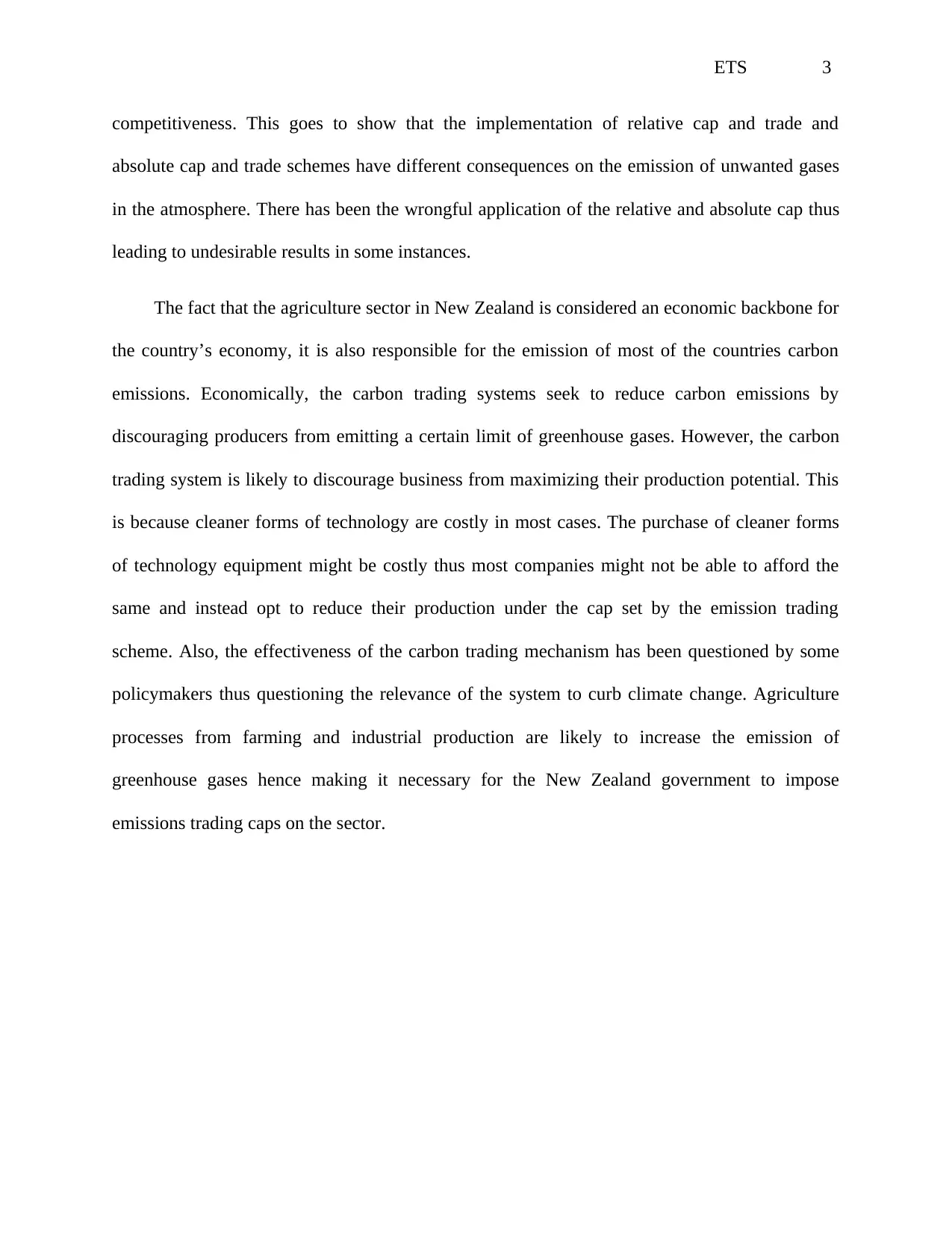
ETS 3
competitiveness. This goes to show that the implementation of relative cap and trade and
absolute cap and trade schemes have different consequences on the emission of unwanted gases
in the atmosphere. There has been the wrongful application of the relative and absolute cap thus
leading to undesirable results in some instances.
The fact that the agriculture sector in New Zealand is considered an economic backbone for
the country’s economy, it is also responsible for the emission of most of the countries carbon
emissions. Economically, the carbon trading systems seek to reduce carbon emissions by
discouraging producers from emitting a certain limit of greenhouse gases. However, the carbon
trading system is likely to discourage business from maximizing their production potential. This
is because cleaner forms of technology are costly in most cases. The purchase of cleaner forms
of technology equipment might be costly thus most companies might not be able to afford the
same and instead opt to reduce their production under the cap set by the emission trading
scheme. Also, the effectiveness of the carbon trading mechanism has been questioned by some
policymakers thus questioning the relevance of the system to curb climate change. Agriculture
processes from farming and industrial production are likely to increase the emission of
greenhouse gases hence making it necessary for the New Zealand government to impose
emissions trading caps on the sector.
competitiveness. This goes to show that the implementation of relative cap and trade and
absolute cap and trade schemes have different consequences on the emission of unwanted gases
in the atmosphere. There has been the wrongful application of the relative and absolute cap thus
leading to undesirable results in some instances.
The fact that the agriculture sector in New Zealand is considered an economic backbone for
the country’s economy, it is also responsible for the emission of most of the countries carbon
emissions. Economically, the carbon trading systems seek to reduce carbon emissions by
discouraging producers from emitting a certain limit of greenhouse gases. However, the carbon
trading system is likely to discourage business from maximizing their production potential. This
is because cleaner forms of technology are costly in most cases. The purchase of cleaner forms
of technology equipment might be costly thus most companies might not be able to afford the
same and instead opt to reduce their production under the cap set by the emission trading
scheme. Also, the effectiveness of the carbon trading mechanism has been questioned by some
policymakers thus questioning the relevance of the system to curb climate change. Agriculture
processes from farming and industrial production are likely to increase the emission of
greenhouse gases hence making it necessary for the New Zealand government to impose
emissions trading caps on the sector.
Paraphrase This Document
Need a fresh take? Get an instant paraphrase of this document with our AI Paraphraser
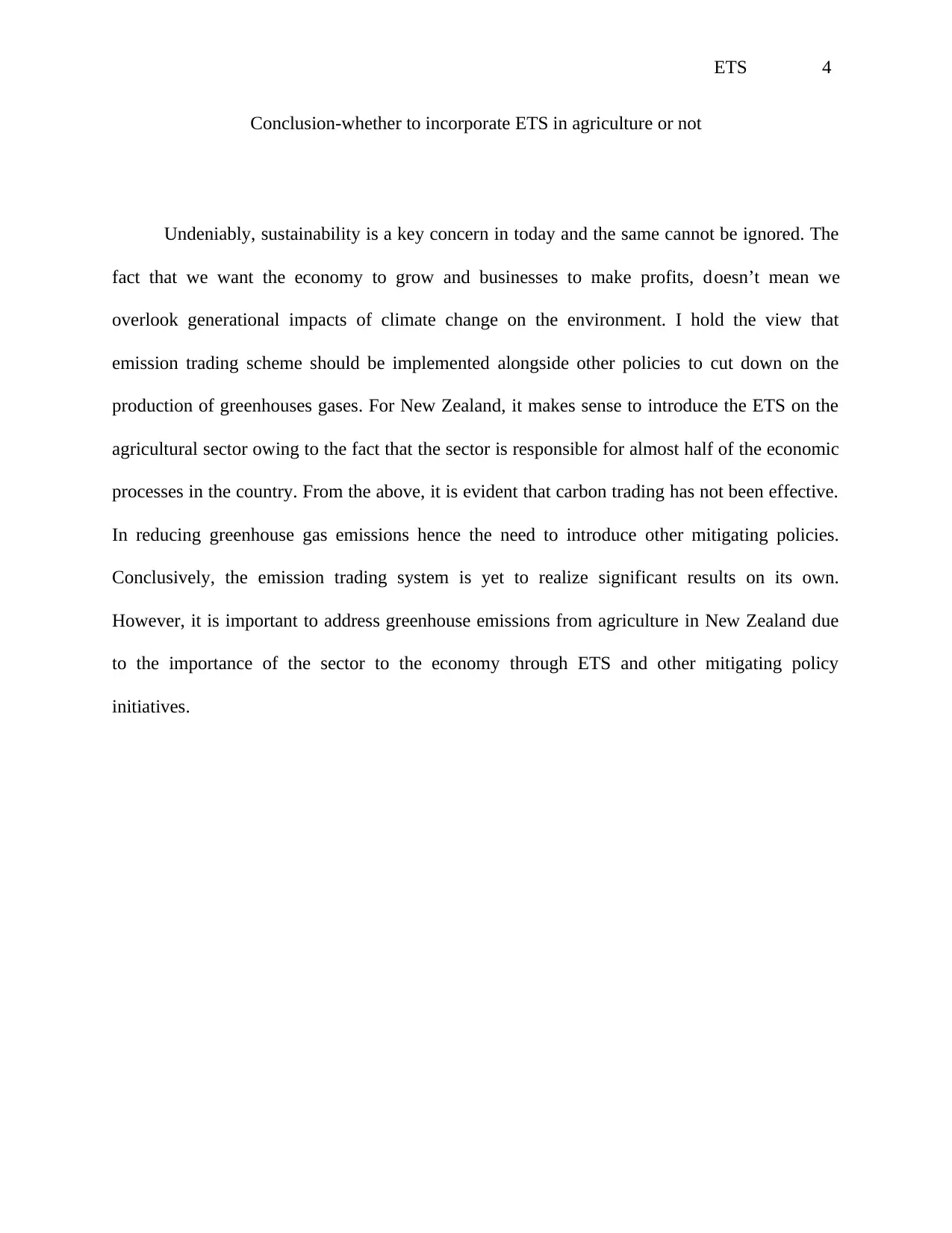
ETS 4
Conclusion-whether to incorporate ETS in agriculture or not
Undeniably, sustainability is a key concern in today and the same cannot be ignored. The
fact that we want the economy to grow and businesses to make profits, doesn’t mean we
overlook generational impacts of climate change on the environment. I hold the view that
emission trading scheme should be implemented alongside other policies to cut down on the
production of greenhouses gases. For New Zealand, it makes sense to introduce the ETS on the
agricultural sector owing to the fact that the sector is responsible for almost half of the economic
processes in the country. From the above, it is evident that carbon trading has not been effective.
In reducing greenhouse gas emissions hence the need to introduce other mitigating policies.
Conclusively, the emission trading system is yet to realize significant results on its own.
However, it is important to address greenhouse emissions from agriculture in New Zealand due
to the importance of the sector to the economy through ETS and other mitigating policy
initiatives.
Conclusion-whether to incorporate ETS in agriculture or not
Undeniably, sustainability is a key concern in today and the same cannot be ignored. The
fact that we want the economy to grow and businesses to make profits, doesn’t mean we
overlook generational impacts of climate change on the environment. I hold the view that
emission trading scheme should be implemented alongside other policies to cut down on the
production of greenhouses gases. For New Zealand, it makes sense to introduce the ETS on the
agricultural sector owing to the fact that the sector is responsible for almost half of the economic
processes in the country. From the above, it is evident that carbon trading has not been effective.
In reducing greenhouse gas emissions hence the need to introduce other mitigating policies.
Conclusively, the emission trading system is yet to realize significant results on its own.
However, it is important to address greenhouse emissions from agriculture in New Zealand due
to the importance of the sector to the economy through ETS and other mitigating policy
initiatives.
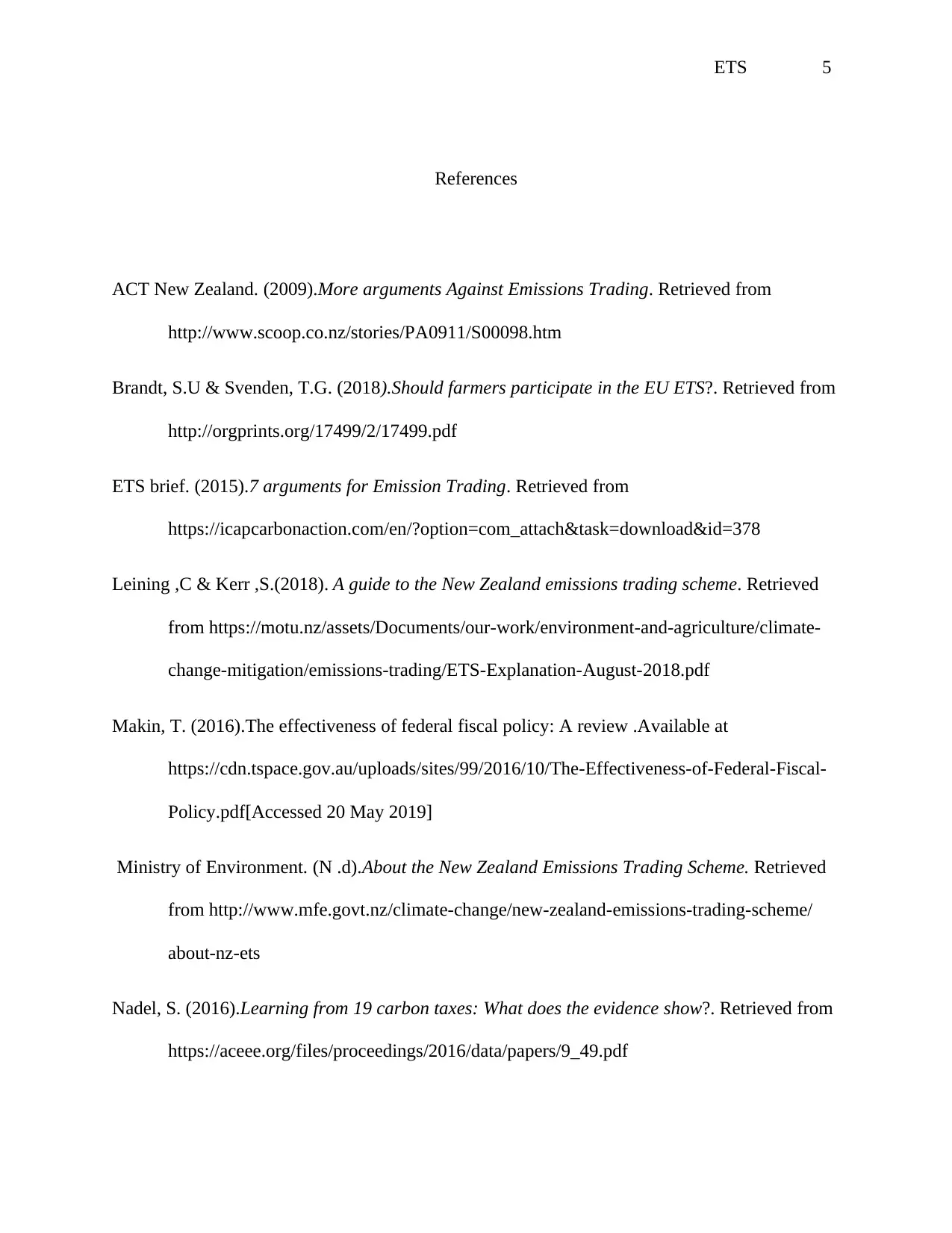
ETS 5
References
ACT New Zealand. (2009).More arguments Against Emissions Trading. Retrieved from
http://www.scoop.co.nz/stories/PA0911/S00098.htm
Brandt, S.U & Svenden, T.G. (2018).Should farmers participate in the EU ETS?. Retrieved from
http://orgprints.org/17499/2/17499.pdf
ETS brief. (2015).7 arguments for Emission Trading. Retrieved from
https://icapcarbonaction.com/en/?option=com_attach&task=download&id=378
Leining ,C & Kerr ,S.(2018). A guide to the New Zealand emissions trading scheme. Retrieved
from https://motu.nz/assets/Documents/our-work/environment-and-agriculture/climate-
change-mitigation/emissions-trading/ETS-Explanation-August-2018.pdf
Makin, T. (2016).The effectiveness of federal fiscal policy: A review .Available at
https://cdn.tspace.gov.au/uploads/sites/99/2016/10/The-Effectiveness-of-Federal-Fiscal-
Policy.pdf[Accessed 20 May 2019]
Ministry of Environment. (N .d).About the New Zealand Emissions Trading Scheme. Retrieved
from http://www.mfe.govt.nz/climate-change/new-zealand-emissions-trading-scheme/
about-nz-ets
Nadel, S. (2016).Learning from 19 carbon taxes: What does the evidence show?. Retrieved from
https://aceee.org/files/proceedings/2016/data/papers/9_49.pdf
References
ACT New Zealand. (2009).More arguments Against Emissions Trading. Retrieved from
http://www.scoop.co.nz/stories/PA0911/S00098.htm
Brandt, S.U & Svenden, T.G. (2018).Should farmers participate in the EU ETS?. Retrieved from
http://orgprints.org/17499/2/17499.pdf
ETS brief. (2015).7 arguments for Emission Trading. Retrieved from
https://icapcarbonaction.com/en/?option=com_attach&task=download&id=378
Leining ,C & Kerr ,S.(2018). A guide to the New Zealand emissions trading scheme. Retrieved
from https://motu.nz/assets/Documents/our-work/environment-and-agriculture/climate-
change-mitigation/emissions-trading/ETS-Explanation-August-2018.pdf
Makin, T. (2016).The effectiveness of federal fiscal policy: A review .Available at
https://cdn.tspace.gov.au/uploads/sites/99/2016/10/The-Effectiveness-of-Federal-Fiscal-
Policy.pdf[Accessed 20 May 2019]
Ministry of Environment. (N .d).About the New Zealand Emissions Trading Scheme. Retrieved
from http://www.mfe.govt.nz/climate-change/new-zealand-emissions-trading-scheme/
about-nz-ets
Nadel, S. (2016).Learning from 19 carbon taxes: What does the evidence show?. Retrieved from
https://aceee.org/files/proceedings/2016/data/papers/9_49.pdf
⊘ This is a preview!⊘
Do you want full access?
Subscribe today to unlock all pages.

Trusted by 1+ million students worldwide

ETS 6
Nell, E, Semmler, W & Rezai, A. (2009).Economic growth and climate Change: Cap-and-
Trade or Emission TAX? Retrieved from
https://www.economicpolicyresearch.org/images/docs/research/climate_change/SCEPA
%20Working%20Paper%202009-4.pdf
Nell, E, Semmler, W & Rezai, A. (2009).Economic growth and climate Change: Cap-and-
Trade or Emission TAX? Retrieved from
https://www.economicpolicyresearch.org/images/docs/research/climate_change/SCEPA
%20Working%20Paper%202009-4.pdf
1 out of 7
Related Documents
Your All-in-One AI-Powered Toolkit for Academic Success.
+13062052269
info@desklib.com
Available 24*7 on WhatsApp / Email
![[object Object]](/_next/static/media/star-bottom.7253800d.svg)
Unlock your academic potential
Copyright © 2020–2025 A2Z Services. All Rights Reserved. Developed and managed by ZUCOL.




